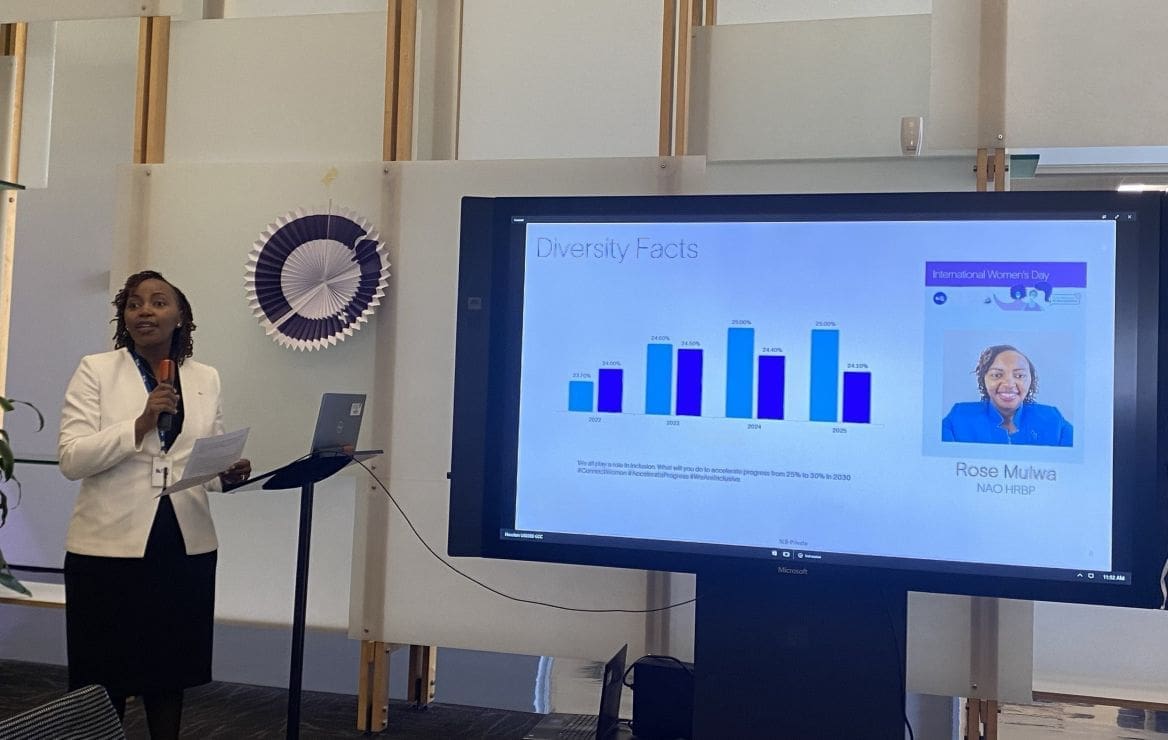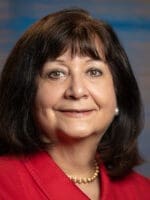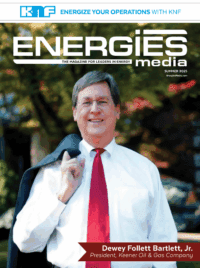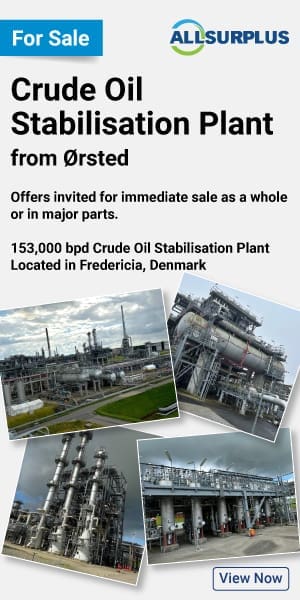Ellen Warren: Tell us about your background. What inspired you to start a career in the oil and gas industry?
Rose Mulwa: I was born in Nyeri, located in the central part of Kenya. My parents worked in government and business jobs, and we farmed on the side, but we lived modestly. This environment inspired me to work hard and strive for a better life, for myself as well as for future generations of my family.
Thanks to my strong academic performance, I was lucky to attend top-ranked primary and high schools, and was admitted to Moi University—but with a two-year delay due to demand pressure on Kenya’s public universities. To make good use of the time, I enrolled at Strathmore University, a top-tier private institution, to begin studying for the Association of Chartered Certified Accountants (ACCA) qualification. I completed Sections 1 and 2 before joining Moi University in 2003. Upon earning my B.S. degree in 2007, I returned to Strathmore to complete my ACCA certification. Later, after relocating to the US for work, I earned a Master’s degree in Leadership and Human Resource Development with a focus on Workforce Development from Louisiana State University.
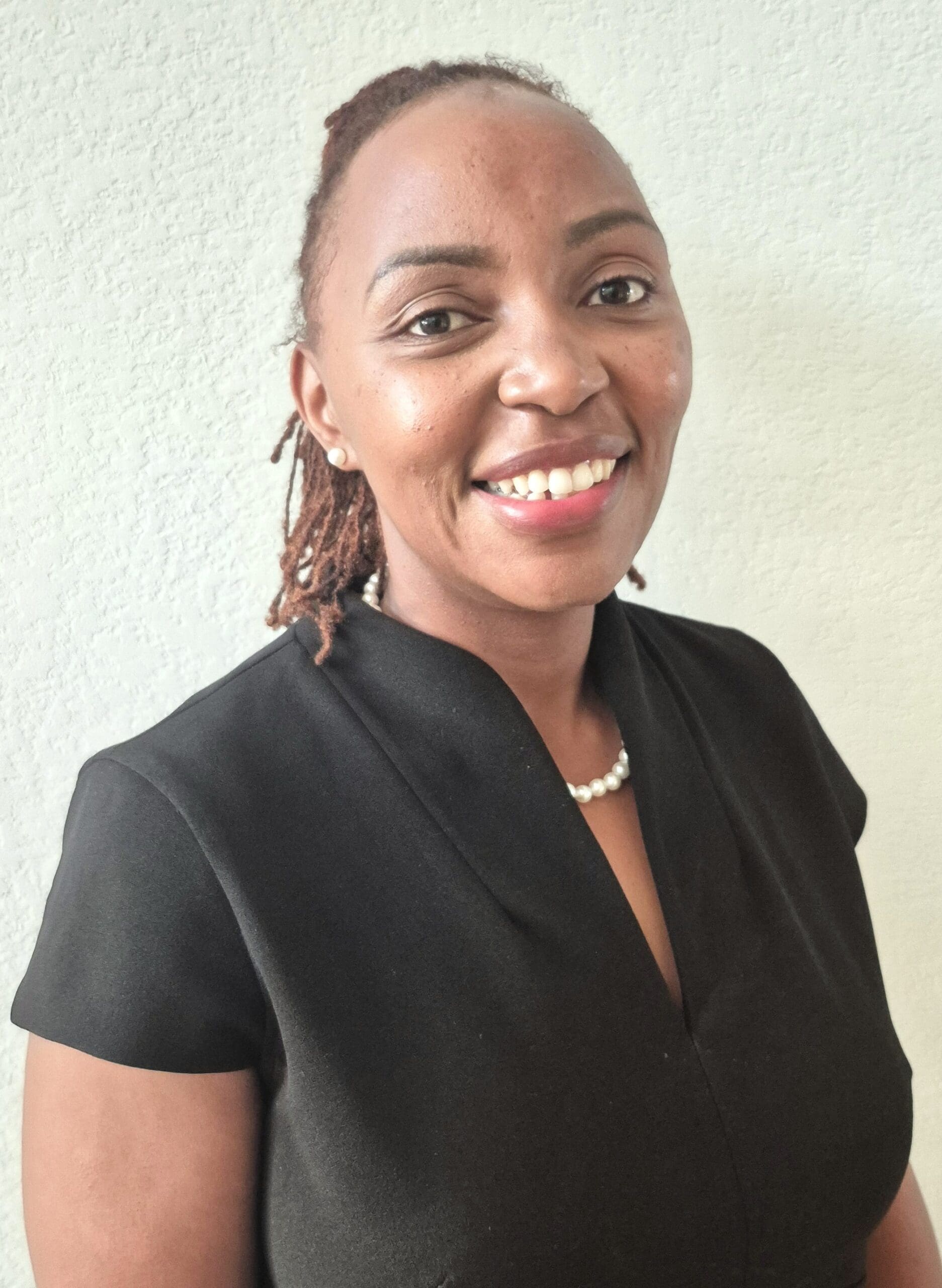
My professional journey began at BGP Kenya Limited, a seismic acquisition company in the oil and gas (O&G) sector. At the time, oil exploration had just begun gaining momentum in the Turkana region, and I was eager to apply my accounting skills in a fast-growing, high-impact industry. Motivated by the opportunity to contribute to a new sector with immense potential, I deliberately joined BGP Kenya as an Accountant, supporting seismic acquisition projects by managing budgets, processing field expenses, maintaining financial records, and ensuring full regulatory compliance. In this role, I prepared annual financial statements in line with International Financial Reporting Standards (IFRS), managed monthly payroll and statutory returns, conducted bank reconciliations, and coordinated external and Kenya Revenue Authority (KRA) audits. I also created financial forecasts, streamlined reporting systems to reduce errors, and produced regular operational and financial reports for submission to the head office.
Although my initial responsibilities were primarily financial, the operational nature of seismic projects naturally expanded my role. Through close collaboration with operations and procurement teams, and regular site visits to seismic camps and exploration areas, I gained first-hand exposure to how seismic crews operate, how seismic lines are laid out, and how field activities are prepared ahead of drilling operations. These experiences allowed me to directly connect financial management with operational efficiency and gave me a deep understanding of how seismic acquisition underpins the broader O&G lifecycle.
In my role at BGP, I supported major clients such as CNOOC, Tullow Oil, Africa Oil, Zarara Oil & Gas, and Taipan Resources with their seismic acquisition programs across Kenya—including in the very blocks where the historic Ngamia-1 well would later be drilled. This early operational exposure, built on a strong financial foundation, positioned me uniquely within Kenya’s nascent energy industry. Working at the intersection of finance and field operations gave me critical insight into how seismic acquisition plays a foundational role in oil and gas exploration, ultimately setting the stage for my future career growth in workforce planning, organizational development, and strategic leadership within the energy sector.
In 2012, as Kenya celebrated its first commercially viable oil discovery in the Tertiary Rift, I was headhunted by my current employer, a leading global oilfield services company, to support their new operations. I became the second employee, and notably the first Kenyan woman, hired at their offshore division, which was providing drilling services to other oil companies engaged in exploration and production (E&P) during this transformative moment in the country’s energy history.
My manager recognized my rare combination of accounting knowledge and sector-specific experience. Under his leadership, I played a key role in establishing the company’s presence in Kenya, helped a major client’s project achieve first oil, and contributed to growing the local team from two to over 100 employees by 2014. I was recognized during a national event marking Kenya’s first oil and was promoted to HR Representative shortly thereafter.
EW: What does your role encompass now? How did you come to your current position?
RM: By 2017, I had expanded my role to support the company’s HR operations across several East and Southern African countries, including Kenya, Tanzania, Uganda, Ethiopia, and South Africa. At the time, the region’s O&G industry faced a critical shortage of skilled talent, while local content laws required companies to ensure that up to 80% of their workforce came from the local population. Human Resources became a strategic driver of success, and I played an instrumental role in supporting several high-profile, multi-billion-dollar projects by leading recruitment, retention, and employee engagement strategies. I also led workforce development initiatives tailored to each country’s economic and legal landscape. These efforts included:
- Designing and implementing labor law training programs for managers across multiple jurisdictions.
- Leading local content compliance in South Africa under the Broad-Based Black Economic Empowerment (BBBEE) framework.
- Creating localized HR websites for each country to enhance the accessibility of policies, benefits, and compliance resources.
- Regularly traveling to the company’s HR Hub in Malaysia to gain certifications in global HR systems, employment law, and benefits administration.
I was proud to contribute to transformative O&G projects that were both commercial successes for my employer and significant developmental milestones for their respective countries. My ability to integrate HR strategy with local compliance and global business goals helped ensure operational excellence and meaningful community impact.
In 2018, I accepted a new challenge in Kuwait, supporting our Production Facilities business, and in 2019, I relocated to the US to support HR for the Completions, Wireline, and Testing segments in the Gulf of Mexico. In 2022, I moved to Houston and currently serve as an HR Business Partner overseeing the North America Offshore business unit, which includes responsibility for more than 500 employees. My journey from a small village in Nyeri to managing HR strategies across continents is driven by a passion for empowering people and building sustainable, inclusive workplaces that fuel innovation, growth, and long-term success.
EW: How does your academic background in accounting contribute to your current role?
RM: My accounting background has been invaluable in my HR leadership roles. It allows me to approach HR initiatives with a financial perspective—evaluating the return on investment (ROI) for talent programs, forecasting labor costs, and ensuring workforce budgets align with business strategies. For instance, when rolling out extensive training or workforce development programs, I don’t just focus on the learning outcomes; I also analyze their cost-effectiveness and impact on key business metrics like productivity and turnover rates. This dual expertise in HR and finance enables me to develop strategies that are both operationally sound and financially viable, resonating with both the operational teams and executive leadership.
EW: You mentioned making HR a strategic driver of success. What is your strategy for making HR a business catalyst in the O&G industry?
RM: My strategy is centered on a dual-lens approach—viewing every HR initiative through both a human capital and a financial perspective. From an HR standpoint, I focus on aligning workforce capabilities with operational goals through Strategic Workforce Planning (SWP), competency-based development programs, and a strong culture of engagement, diversity, and inclusion.
Simultaneously, I apply a financial lens to ensure that HR decisions contribute directly to business performance. This means evaluating the cost-effectiveness, ROI, and long-term impact of every talent initiative, not just from a people perspective, but also from a business sustainability standpoint. By balancing these two lenses, HR shifts from being a support function to becoming a catalyst for business growth, resilience, and innovation.
EW: How does your dual-lens approach improve operational efficiency, increase employee retention, reduce workforce vacancy rates, and optimize business outcomes?
RM: This dual-lens approach drives measurable improvements across key business areas. Through SWP, we anticipate future skill needs, align talent pipelines to project timelines, and proactively invest in upskilling and reskilling initiatives. This ensures that critical roles are filled faster, minimizing vacancy rates and reducing operational disruptions.
By linking talent strategies directly to budgetary planning, we optimize headcount allocation, minimize unnecessary labor costs, and prioritize investments in high-impact development programs. This disciplined approach to workforce readiness strengthens employee engagement and retention by offering clear career pathways and continuous growth opportunities. Ultimately, it creates a more agile, cost-efficient workforce capable of meeting both current operational demands and future business objectives—resulting in higher productivity, reduced downtime, and stronger financial performance.
EW: You have built your career by integrating a strong understanding of the industry’s technical and business requirements into your HR strategy. Change management is currently a critical topic in enterprise C-suites. How do you collaborate with the Operations system team and other functional teams to make HR a driver for change management and organizational efficiency?
RM: I view HR as a central enabler of change management and organizational efficiency, particularly when working alongside Operations system teams and other functional groups. My approach starts with early alignment—engaging cross-functional leaders at the design phase of major initiatives to ensure workforce impacts are anticipated, not an afterthought.
In partnership with Operations and functional teams, I use data-driven insights from systems like, PowerBI dashboards, and operational KPIs to map workforce capabilities to business needs. Together, we co-develop change strategies that address both the technical and human dimensions—structuring clear communication plans, reskilling programs, transition support mechanisms, and accountability frameworks.
Additionally, I champion structured feedback loops to continuously assess the organizational climate throughout the change journey. This real-time feedback enables Operations and HR to jointly make adjustments that improve adoption, minimize resistance, and maintain productivity. By embedding HR in operational and system workflows, we ensure that change initiatives are both technically sound and culturally sustainable—ultimately accelerating business outcomes and organizational resilience.
EW: Can you tell us more about how your workforce development initiatives improve the effectiveness of O&G projects and production operations?
RM: Workforce development is a critical lever for improving both the efficiency and success of O&G projects and production operations. My initiatives are built around a proactive, skills-based approach—aligning workforce capabilities with project demands before operational needs peak. By implementing SWP and competency-based development programs, we ensure that employees are technically ready, safety-conscious, and operationally aligned at every phase of a project. This minimizes project delays, reduces HSE risks, and ensures faster time-to-productivity for new teams.
For example, on major offshore projects, we’ve structured early upskilling programs in maintenance, HSE compliance, and well intervention techniques, which directly contributed to lower non-productive time (NPT) and improved project delivery timelines. By continuously mapping training to operational milestones, workforce readiness becomes a competitive advantage—reducing downtime, optimizing resource utilization, and enhancing overall production efficiency. Ultimately, these initiatives don’t just fill roles; they build resilient, high-performing teams that are equipped to adapt to technical challenges and sustain operational excellence over the long term.
EW: What are your strategies or best practices for driving employee engagement in O&G?
RM: In the O&G industry—where operational demands are high and environments can be challenging—driving employee engagement requires a deliberate, multi-layered approach. My strategies focus on creating clear career pathways, fostering continuous development, and building a culture of inclusion and recognition.
First, I align engagement initiatives with SWP, ensuring employees see a future within the organization through competency-based development programs like structured technical and professional programs. Clear career progression tied to skills development boosts motivation and retention.
Second, I prioritize transparent communication, especially around business goals, project milestones, and organizational changes. Frequent touchpoints through town halls, engagement surveys, and leadership forums ensure employees feel heard and connected to the broader mission.
Third, I promote employee-driven learning and wellness initiatives that recognize the physical and mental demands of O&G work. Programs that focus on skill-building, health, safety, and family support strengthen employee loyalty and resilience.
Finally, I integrate engagement into operational workflows by partnering with line managers to embed recognition, coaching, and feedback into everyday work—not just annual reviews. High engagement isn’t just a program—it’s a culture that supports performance, innovation, and long-term business success.
EW: What do you think are some of the greatest HR challenges in the O&G industry today?
RM: The O&G industry is facing a unique convergence of HR challenges that demand strategic action. Talent attraction and retention are major hurdles. As the industry evolves toward digitalization and sustainability, competition for highly skilled technical talent—especially in areas like automation, data analytics, and low-carbon technologies—has intensified. Younger generations are also more selective, prioritizing purpose-driven work and sustainable practices, which means O&G companies must reposition themselves as employers of choice.
Workforce transformation and reskilling are also critical. Traditional skill sets are no longer sufficient. HR must lead the charge in upskilling and reskilling employees to adapt to new technologies, operational models, and the energy transition toward cleaner fuels.
Organizational agility remains a major challenge. O&G projects often operate in volatile, high-risk environments. HR must design more agile organizational structures, strategic workforce plans, and flexible talent models that can scale up or down quickly in response to shifting market conditions.
Finally, employee engagement and well-being are increasingly important. The high-pressure nature of O&G work can impact mental health, safety, and overall workforce stability. HR strategies must not only focus on operational performance, but also on building supportive, inclusive environments where employees can thrive both personally and professionally. Addressing all these challenges requires HR to be more strategic, technology-enabled, and deeply integrated into the core business than ever before.
EW: How are you attracting and recruiting young people into the industry? Are there new hiring obstacles as compared to previous periods in your career?
RM: Attracting young talent into the O&G industry today requires a different approach than in the past. Early in my career, brand recognition and competitive compensation were often enough to attract candidates. Today, young professionals are looking for more—they want purpose, career growth, innovation, and a commitment to sustainability.
To meet these expectations, I focus on several key strategies. We highlight the industry’s role in driving energy transition, innovation, and community development, not just traditional hydrocarbon production. Building early pipelines through internships, scholarships, and on-campus engagement gives students real-world exposure to the industry’s evolving opportunities. We also focus on competencies like digital fluency, problem-solving, and adaptability, rather than only traditional technical degrees, broadening our talent pools. By showing clear, structured development programs and long-term career progression opportunities, we cater to the needs of Gen Z and Millennial candidates. Additionally, we use modern recruiting platforms, social media, and virtual events to meet young people where they are, making the process more accessible and engaging.
Compared to earlier in my career, new obstacles include overcoming outdated perceptions of the industry, competing with tech and renewable energy sectors for the same talent, and adapting to candidates who prioritize flexibility, continuous learning, and meaningful work over traditional incentives alone. Attracting young talent now requires a holistic strategy that connects personal values with industry innovation—and positions O&G as a dynamic, forward-thinking career choice.
EW: Where do you see the most opportunities for young professionals entering the oil sector? What main technical skills do you think will be needed to advance in the O&G industry?
RM: There are tremendous opportunities for young professionals entering the O&G sector today, particularly at the intersection of traditional energy operations and emerging technologies. Areas such as digital oilfield operations, data-driven reservoir management, subsea engineering, carbon capture and storage (CCS), and energy transition initiatives offer exciting growth paths. Young professionals who can bridge operational expertise with digital innovation will have a distinct advantage.
Proficiency in data science, machine learning, and AI applications for optimizing drilling, production, and maintenance activities is becoming essential. Understanding robotics, remote operations, and automated production systems will be critical as the industry pushes for efficiency and safety. Skills in emissions reduction technologies, renewable integration, and sustainable energy systems will be increasingly important as companies diversify their energy portfolios. Core engineering disciplines (mechanical, petroleum, chemical, subsea) combined with strong project execution skills will always be fundamental, especially for complex offshore and deepwater developments. As regulatory environments tighten and ESG expectations rise, expertise in HSE standards and environmental stewardship will be a valuable differentiator.
Young professionals who combine technical excellence with adaptability, digital fluency, and a strong commitment to innovation and sustainability will not only succeed—they will lead the future of the oil and gas industry.
EW: How could the industry improve its initiatives to attract young engineers? What advice would you give to people interested in pursuing a career in O&G?
RM: The industry must rethink both its outreach and value proposition, and modernize its image. Many young professionals today are looking for careers that align with sustainability, technology, and purpose. O&G companies should highlight the critical role they play in the energy transition—through innovations in cleaner energy production, carbon capture, and digitalization—rather than relying solely on traditional narratives.
Early engagement is key. Building strong partnerships with universities, sponsoring STEM programs, offering meaningful internships, and providing real-world exposure to cutting-edge projects can spark interest before students even graduate. Additionally, companies should invest in mentorship programs and career development pathways that show a clear, exciting future for young engineers within the sector.
Lastly, flexibility and diversity must be prioritized. Offering flexible career paths, international mobility, multidisciplinary roles, and fostering an inclusive environment can make the industry more attractive to a broader talent pool.
My advice to those interested in a career in O&G is to be curious and open to continuous learning. The industry is evolving rapidly, driven by technology, environmental concerns, and new forms of energy. Engineers who embrace adaptability—whether learning about data science, automation, or sustainability practices—will be best positioned for success. Seek out hands-on experience early. Field exposure, internships, and multidisciplinary project work will give you a stronger foundation than classroom knowledge alone. Finally, stay globally minded: energy is a global business, and international exposure can accelerate both your technical and leadership growth.
Ellen F. Warren writes about industry leaders and trends in various sectors, including energy, fintech, IT innovation, healthcare, business, logistics, supply chain, commercial real estate, and entrepreneurship.As a former Independent Director, she served for more than a decade on the Boards of multiple E&P companies in the oil and gas industry.

